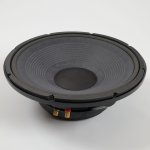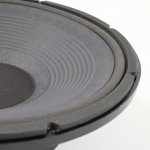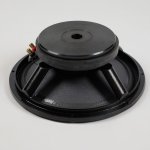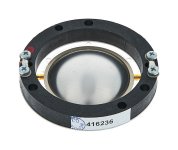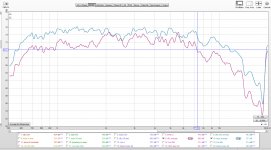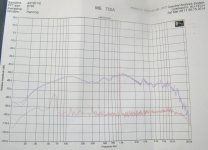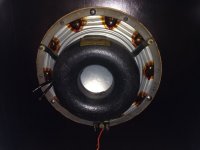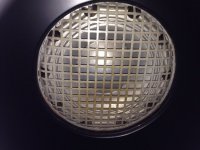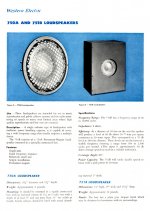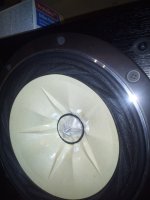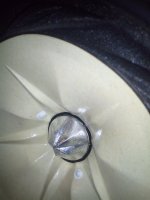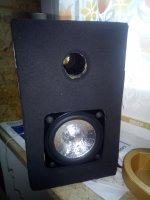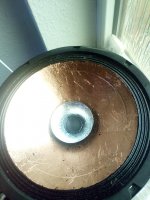The woofer used is a rather esoteric and expensive one (€ 910,00).
The cone and foam surround resemble those of the famous JBL 2235.
T&S:
Nominal impedance Z 8ohm
Mean sound pressure level 98 dB
Resonance frequency fs 25.5 Hz
Rated power 200 W
Outside diameter 390 mm
Total Q factor Qts 0.26
Equivalent volume Vas 530 L
Electrical Q factor Qes 0.29
Mechanical Q factor Qms 2.53
Dynamically moved mass Mms 72 gr
Compliance susp. (CMS) 0.54 m/N
BL 17.29 N/A
Weight 10 Kg
Diameter of the motor 224 mm
The cone and foam surround resemble those of the famous JBL 2235.
T&S:
Nominal impedance Z 8ohm
Mean sound pressure level 98 dB
Resonance frequency fs 25.5 Hz
Rated power 200 W
Outside diameter 390 mm
Total Q factor Qts 0.26
Equivalent volume Vas 530 L
Electrical Q factor Qes 0.29
Mechanical Q factor Qms 2.53
Dynamically moved mass Mms 72 gr
Compliance susp. (CMS) 0.54 m/N
BL 17.29 N/A
Weight 10 Kg
Diameter of the motor 224 mm
Attachments
Some relevant documents on woofers.
Quote:
HIGH-SENSITIVITY TRANSDUCERS:
Primary use is in sound and music reinforcement, mounted in horn and direct radiator reflex-type enclosures.
For these purposes LF cone excursion has been limited and sensitivity increased, relative to the transducers of the medium sensitivity class, in order to get greater output in the 50 or 60 Hz range up to 800 Hz.
Quote:
HIGH-SENSITIVITY TRANSDUCERS:
Primary use is in sound and music reinforcement, mounted in horn and direct radiator reflex-type enclosures.
For these purposes LF cone excursion has been limited and sensitivity increased, relative to the transducers of the medium sensitivity class, in order to get greater output in the 50 or 60 Hz range up to 800 Hz.
Attachments
When you say limited Xmax....say for a 15"...how limited are we talking? 2mm? It would seem that driver compliance would be more important. Say you have 2 drivers, same diameter...matching qts...everything else the same but one has 2mm xmax, the other 10mm....where does the sonic difference occur in the shorter xmax favor?
Nothing since they need to be compared at the 2 mm driver's max power handling if all else equal, but normally the high Xmax driver will have a much 'beefier' motor system, so mechanical, thermal losses will be higher.
To compare them then, we need to compare based on reference efficiency where the SPL is the same at rated Xmax power, which doesn't take much imagination as to which will sound best overall in its mid-band where our hearing acuity is focused.
Much of the performance gap between the two can be designed out, but I imagine the cost of both would initially skyrocket even if the Babb/DC Gold patent with its roller bearing/spider-less design is used.
Last edited:
A 2 way system from the same manufacturer as the MTM, that was posted a few pages earlier.
I quite like how this looks.
I recently tested some 2425J drivers and I'd guesstimate that you'd go with a 700Hz crossover on a horn that big.
Their claim of 21kHz extension is marketing magic.
13-15kHz is more realistic:
The 2425Js Are SWEET!, but what Horn did I get? - Page 3
The JBL 2426J - including a Radian Alu diaphragm, was tested by another Frenchman:
Was there meant to be a link here? I'm curious to know the results.
for me it is an outdated compression that is history.
500 Euro is a ridiculous amount for this driver.
Yep. My pair were salvaged out of cabinets that I picked up cheaply. I wouldn't pay the price they cost new.
Note that they do have one application in which they are probably better than modern drivers:
Big, long, vintage-style horns. The 2" Inlow horn is a good example.
Until the 80s, JBL made all their drivers with deep throats / low flare rates built into them, i.e. 1930s geometry (see Technical Note Volume 1 Number 21 - JBL Professional).
Vintage JBL drivers can still be found for next to nothing in the US and other countries outside the EU. If the phrams are shot, the Radians seem like a nice alternative.
I don't think any of the vintage JBL drivers are bad, quite the contrary. But somehow JBL is synonymous with expensive over here.
Here's the 1" comparison, including the 2426J (in French > use translate).

I don't think any of the vintage JBL drivers are bad, quite the contrary. But somehow JBL is synonymous with expensive over here.
Here's the 1" comparison, including the 2426J (in French > use translate).

Attachments
Great info, thanks.
I have also measured several drivers on that same horn (I tried the JBL vs some cheap new units).
Mine show a similar HF rolloff to what they measured, but they are less in need of eq, so I guess I will stick with the diaphragms I have.
I should, however, open them up to check for grit / rubbing.
Image: blue line = response on the cheap expo horn (vs the JBL 2370 horn).
This is 1/48 smoothing and not on a baffle. Putting them on a baffle will add another couple of dB at the low end, and make them more usable for a cross <1kHz.
I have also measured several drivers on that same horn (I tried the JBL vs some cheap new units).
Mine show a similar HF rolloff to what they measured, but they are less in need of eq, so I guess I will stick with the diaphragms I have.
I should, however, open them up to check for grit / rubbing.
Image: blue line = response on the cheap expo horn (vs the JBL 2370 horn).
This is 1/48 smoothing and not on a baffle. Putting them on a baffle will add another couple of dB at the low end, and make them more usable for a cross <1kHz.
Attachments
All the (best) mid woofers I know (capable of playing > 500 Hz) have curved (light) diaphragms and limited Xmax.
I agree with this in general but there are also exceptions to this rule. The famous TAD drivers for instance are straight curved but work quite well into the midrange.
Regards
Charles
My experience with TAD is extremely limited, but I know the 1603 is supposed to be good up to around 800 Hz, as is the JBL 2226H.
Still, I don't think both of these match the best woofers with convex cones wrt mid range performance, or perhaps articulation is more appropriate in this respect.
Woofer cones and surrounds constitute a field of research in themselves.
A quote:
"A commonly used cone material, for example paper, has a much smaller ratio of E/ρ (stiffness to density) and a much larger material damping, which is able to damp the bending resonances effectively. Therefore the convex cone shape is optimum for such a cone material: the sound pressure response shows a smooth curve."
Still, I don't think both of these match the best woofers with convex cones wrt mid range performance, or perhaps articulation is more appropriate in this respect.
Woofer cones and surrounds constitute a field of research in themselves.
A quote:
"A commonly used cone material, for example paper, has a much smaller ratio of E/ρ (stiffness to density) and a much larger material damping, which is able to damp the bending resonances effectively. Therefore the convex cone shape is optimum for such a cone material: the sound pressure response shows a smooth curve."
Last edited:
There is no such thing as "paper"" in general for cones. The material properties vary wildly in reality from almost felt like (e.g. AR 3A woofer) to very hard pressed, resin filled materials. So one cannot generalize about stiffness to density ratio's: within the category "paper these differ a lot already.
I was amazed to learn that aluminium was used in old loudspeakers right from the beginning.
Bozak used aluminium covered paper diaphragms.
Emil Podzus had a patent in the 30ies of the 20th century for stiff diaphragms on a foam basis one sided with aluminium foil as a supporting layer.
Later D.A. Barlow used the sandwich cone - a polystyrene cone with aluminium foil on both sides.
Bozak used aluminium covered paper diaphragms.
Emil Podzus had a patent in the 30ies of the 20th century for stiff diaphragms on a foam basis one sided with aluminium foil as a supporting layer.
Later D.A. Barlow used the sandwich cone - a polystyrene cone with aluminium foil on both sides.
Manufactured in 1938: 750A + 751A = 751B monitor system
For broadcasting station monitor (music playback)
Hard suspended metal cone
Impedance 8 ohms
Maximum allowable input 20W
Frequency characteristic 60(80)~10000hz
9.5 inches (24.13 cm) OD
Inside cone 8 inches (20.32 cm)
Cap size 4 inches ( 10.16cm edgewound aluminum voice coil )
Weight 4.08 kg
Unit price* :
:
'2005 : $5000
'2010 : $15000
'2012 : $25000
'2014 : $35000
* This is the price per unit based on transaction related records.
The price per pair is based on the condition of the 751a enclosure and the condition of the unit pair. It may differ depending on the number difference.
For broadcasting station monitor (music playback)
Hard suspended metal cone
Impedance 8 ohms
Maximum allowable input 20W
Frequency characteristic 60(80)~10000hz
9.5 inches (24.13 cm) OD
Inside cone 8 inches (20.32 cm)
Cap size 4 inches ( 10.16cm edgewound aluminum voice coil )
Weight 4.08 kg
Unit price*
'2005 : $5000
'2010 : $15000
'2012 : $25000
'2014 : $35000
* This is the price per unit based on transaction related records.
The price per pair is based on the condition of the 751a enclosure and the condition of the unit pair. It may differ depending on the number difference.
Attachments
Last edited:
Metal and paper in combination
I like the combination of metal and paper for loudspeaker diaphragms.
I am impressed to see a metal cone driver from 1938, I only read about Jordan / Watts using them in the sixties but the idea is much older.
Here some work I did for myself - paper cones with aluminium foil.
For design purpose you can also use copper foil - looks vintage alike.
Aluminium has in my eyes a space age look.
I even grabbed a bluetooth speaker and tweaked the diaphragm.
Here what Barlow stated:
D.A. Barlow: The Development of a Sandwich-Construction Loudspeaker System. Page 159-171. From the AES anthology of articles on loudspeakers, article written 1970.
Citation begin (page 160):
"As paper cones are thin, these resonances are bending modes. The stiffness of a material in bending, for any given geometry and edge condition, is proportional to Young`s modulus and the cube of the thickness, ignoring variations in Poisson`s ratio. ... On this basis, paper is much stiffer than metals (except beryllium) in spite of its much lower modulus, and lower density materials such as expanded plastics are even stiffer, as may be seen in Table. A method of obtaining still greater stiffness is sandwich construction. ... In bending, the maximum stress and strain occur at the outer fibers, the material at the neutral axis being unstressed. Better use of material can thus be made by concentrating it at the outer fibers. A familiar example is the tube. In the case of large areas, the same effect is obtained by using a thin high-modulus material for the outer surfaces, and a light-weight material or form of construction for the core. ... This sandwich will of course be much stiffer than the same total weight of either material used separately. The skin material should have the maximum ratio of modulus/density. Beryllium, the best material, is impractical due to difficulty of rolling and possible toxicity, so aluminium is the obvious choice. The core should be as stiff as possible in the thickness direction and have minimum density. Honeycomb aluminium or impregnated paper are frequently used in aircraft construction and could be used for flat diaphragms."
Citation end.
I like the combination of metal and paper for loudspeaker diaphragms.
I am impressed to see a metal cone driver from 1938, I only read about Jordan / Watts using them in the sixties but the idea is much older.
Here some work I did for myself - paper cones with aluminium foil.
For design purpose you can also use copper foil - looks vintage alike.
Aluminium has in my eyes a space age look.
I even grabbed a bluetooth speaker and tweaked the diaphragm.
Here what Barlow stated:
D.A. Barlow: The Development of a Sandwich-Construction Loudspeaker System. Page 159-171. From the AES anthology of articles on loudspeakers, article written 1970.
Citation begin (page 160):
"As paper cones are thin, these resonances are bending modes. The stiffness of a material in bending, for any given geometry and edge condition, is proportional to Young`s modulus and the cube of the thickness, ignoring variations in Poisson`s ratio. ... On this basis, paper is much stiffer than metals (except beryllium) in spite of its much lower modulus, and lower density materials such as expanded plastics are even stiffer, as may be seen in Table. A method of obtaining still greater stiffness is sandwich construction. ... In bending, the maximum stress and strain occur at the outer fibers, the material at the neutral axis being unstressed. Better use of material can thus be made by concentrating it at the outer fibers. A familiar example is the tube. In the case of large areas, the same effect is obtained by using a thin high-modulus material for the outer surfaces, and a light-weight material or form of construction for the core. ... This sandwich will of course be much stiffer than the same total weight of either material used separately. The skin material should have the maximum ratio of modulus/density. Beryllium, the best material, is impractical due to difficulty of rolling and possible toxicity, so aluminium is the obvious choice. The core should be as stiff as possible in the thickness direction and have minimum density. Honeycomb aluminium or impregnated paper are frequently used in aircraft construction and could be used for flat diaphragms."
Citation end.
Attachments
I think the future of diagram building can be seen in the Axi2050. The idea of "micro" sculpting the geometry in the favor of SQ. I imagine a 3d printed diaphragm with some kind of geometrical bracing within its printed structure. Resin(epoxy?)+paper pulp is probably hard to beat is my guess. The different print materials may provide some unique options and being able to print a diaphragm with some kind of geometrical bracing (honey comb or some variant) may create this light and rigid goal we are looking for without the high cost of material.
What is Krylon? and how does this compare to BE?
What is Krylon? and how does this compare to BE?
I don't remember if I showed my mid woofer, front baffle...its just two panels glued and screwed...smaller panel fits snug inside the enclosure inner dimensions. I have to attach the back/front baffles on all enclosures and then nothing is left to do but install connectors...damping material and a finish. Hopefully I can get some measurements up tonight or tomorrow...cutting this damping material will be a chore.
Attachments
Last edited:
Beryllium (BE) is a steel gray metal with a close-packed hexagonal crystal structure. It has exceptional stiffness, a Young's modulus of 287 GPa. The modulus of elasticity of beryllium is approximately 50% greater than that of steel. The combination of this modulus and a relatively low density results in an unusually fast sound conduction speed in beryllium – about 12.9 km/s at ambient conditions. Very lightweight, stiff (and very expensive) great for material for HF diaphragms.What is Krylon? and how does this compare to BE?
Krylon is a brand of spray paint, not much comparison to BE, other than it is also available in a steel gray color.
Last edited:
3d sculpting as the future of diaphragm? Camplo, aren't corrugation used since... long time ago?
Another example of not so new product using it (in case the one Freedom666 posted wasn't enough.)
15W/8530K00 – Scan-Speak A/S
Honeycomb are not new too... in fact i listen to aluminium honeycomb for more than 25 years!
Adrian-Kingston.com - Technics SB-M1
Mine are M2 not M1.
Can't wait to see your measurements.
Another example of not so new product using it (in case the one Freedom666 posted wasn't enough.)
15W/8530K00 – Scan-Speak A/S
Honeycomb are not new too... in fact i listen to aluminium honeycomb for more than 25 years!
Adrian-Kingston.com - Technics SB-M1
Mine are M2 not M1.
Can't wait to see your measurements.
Last edited:
Those speakers are just as "wow" as the yamaha ns line. Just when you think you've seen it all lol. Guess theres not much new under the sun...Still, 3d printing may have some surprises for us since the ease of manufacturing, particularly in the DIY, has never been so easily accomplished.
- Home
- Loudspeakers
- Multi-Way
- Is it possible to cover the whole spectrum, high SPL, low distortion with a 2-way?
